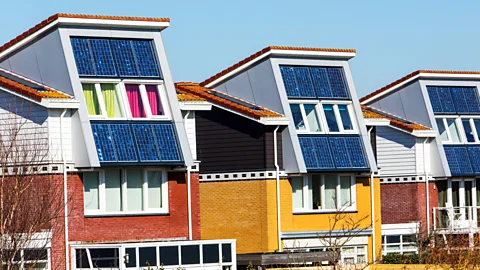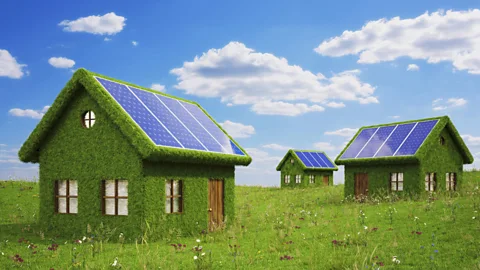Could you go off-grid?
 Alamy
AlamyIn a few months, Bethany Schweitzer and her husband hope to be generating most of their own electricity through solar panels installed on the roof of their house. Driven by a desire to live an eco-friendlier life, they crunched the numbers and sought approval for the panels from their homeowners association, which is pending.
“Initial cost was our biggest concern, but the tax incentives and low-interest loan options made this a feasible option,” said Schweitzer, 36, who lives in Columbus, Ohio, in the US.
Their city doesn’t allow them to disconnect from the electrical grid entirely, but that means they can purchase the small amount of electricity they might need in the winter when solar power is tougher to generate. “I’m excited that our home will be just a bit greener,” Schweitzer said, “and for our lower bills once the loan is paid off.” They expect to save about $2000 per year after making the switch.
In the US, the solar industry grew 34% in 2014 and there were 195,000 installations of solar technology in homes and businesses, according to the Solar Energy Industries Association.
In the UK, solar power almost doubled in 2014 according to the Department of Energy and Climate Change, and in Australia, more than one million homes have rooftop solar power systems, according to the Clean Energy Regulator.
 Thinkstock
Thinkstock“Even in urban areas you’re starting to see more people not necessarily converting an entire house, but you’re seeing solar panels pop up on people’s roofs,” said Robert Richardson, founder of OffGridSurvival.com in the US. “It’s definitely something that’s growing in popularity.”
If you’re thinking about kissing your power company goodbye, here’s what you should know.
What it will take: Off-the-grid life means you’ll need to be energy conscious and willing to make lifestyle changes. “If you’re a tech-y gadget person where your life is electronics, it’s going to be extremely hard for you to go completely off the grid,” Richardson said. That’s because while other products have been ‘greened’ to use less power, electronics still pull a lot of electricity for a solar-only home. “They’re not thinking ‘eco-friendly’ when they’re building them,” Richardson said.
How long you need to prepare: The technology may only take a few weeks or a couple of months to install, but planning may take longer. “Designing an off-grid power system boils down to three things,” said Dan Fink, adjunct professor of solar energy technologies at the Ecotech Institute in Colorado in the US. “What are your energy needs each day, what are your resources for solar, wind or hydro power, and how much are you willing to change your lifestyle to account for the periods when you have no power coming in?”
Solar power is by far the most popular form of residential alternative energy. Wind turbines can also be helpful, but experts suggest living on an acre or more of land or in a rural area before considering one. Keep in mind, too, that the average height of a small horizontal wind turbine is about 80 feet (24.4 metres) high, or twice the height of a telephone pole. Vertical axis wind turbines are a more residential-friendly option, but don't generate as much energy and are generally a supplemental solution. Hydro power is only an option if you have access to falling or flowing water nearby.
Want to try solar out? Take baby steps. “For example, take just one room off the grid with a solar panel and a battery,” said Nick Rosen, UK author of How to Live Off Grid and editor of off-grid.net. “Or go off-grid one day a week.”
 Thinkstock
ThinkstockDo it now: Calculate your energy usage. Understand how much energy you’re pulling on a daily, weekly and monthly basis before shelling out for a new system. “There are inexpensive meters you can buy at any hardware store, such as the Kill-a-Watt Electricity Monitor,” Fink said. Plug any appliance into it and it will count how much energy you’re using over a period of time. There are also tools you can hook into your breaker box that will measure whole-house energy.
Make sure you can afford it. “The upfront cost of putting in solar panels can cost as high as $38,000 to install the panels, $14,000 for the panels themselves, $20,000 for professional setup and $4,000 for a back-up generator,” said Mayer Dahan, CEO of Prime Five Homes, an eco-friendly real-estate development company in Los Angeles.
But, consider that tax credits and other incentives can reduce the upfront cost significantly. In the US and UK, sometimes you can get panels for no money down or take advantage of state incentives for residents who use them. Some municipalities give breaks on property taxes. Power companies may also agree to pay you for any excess electricity you provide to the grid.
In the UK, you may be eligible for the government’s Feed-in Tariffs scheme, whereby you get paid by your energy supplier for the electricity you create, even if you use it. (Although there’s movement afoot in the UK to cut subsidies after a boom in solar panel installation.) In Australia, you might qualify for a solar rebate, subsidy or grant from the government.
Plus, a recent study from the US Department of Energy’s Lawrence Berkeley Laboratory found that host-owned solar panels (that is, not leased) could add $15,000 to your home value. Add that to your annual energy savings — some estimates suggest that the average solar-panel system will save you about $20,000 over 20 years — and you could recoup your costs faster than you think.
Take your environment into account. Does your area get massive snow storms that last for days? Do you have a north-facing roof? Trees that create shade over your home? “If the lot is extremely shaded, the solar panels will not be used to their full potential,” Dahan said. It’s also a tough buy if you only get three hours of good sunshine during the day in your part of the country. You may be able to generate some — but not all — of your power, or look toward another form of energy if wind or water are available to you.
 Alamy
AlamyEven if you’re willing to make electrical sacrifices, your setup simply may not be ideal for generating your own juice. Or the backup batteries required may be expensive. “It costs money each month just to own a battery bank to store energy,” Fink said. “Batteries have limited lifespans even if you don’t use them that often. Most households can count on $40 to $100 per month just for the privilege of having battery storage when the sun isn’t shining.”
Learn to time your electrical tasks. “Off-grid living requires what we call ‘load shifting,’ meaning simply that when you are flush with extra energy coming in on a sunny day, you can run your heavy energy loads, such as housecleaning and laundry,” Fink said, “instead of relying on your battery bank.”
Adapt your house to lower-energy living. “In our homes, we put in large windows to reduce the need to even turn on the lights until the evening,” Dahan said. “We also put in smart house technology so our home buyers can reduce their electricity costs.”
Do it later: Track down vampire loads. These are instant-on appliances or devices with clocks or timers, or cell phones that stay plugged in. “All of these draw a trickle charge that adds up,” said George Sullivan of Net Zero Analysis & Design in Illinois in the US. If you plug these devices into a surge protector you can turn them all off at once when you leave a room.
Do it smarter: Consider staying partially connected. Remaining hooked up to the grid, even when you're generating your own power, provides a backup. “What I recommend to people who have grid power available is that they use it,” Fink said. “They sign up with a power company and set up so they can buy and sell power from the grid. It’s the world’s highest tech and most reliable battery bank.”
